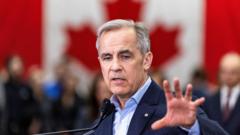Trump revealed the missile defense plan earlier this week, with a preliminary cost of $25 billion, claiming Canada has shown interest in participating. Concerns about the feasibility of the U.S. delivering a robust system persist, alongside uncertainties regarding Canada's financial commitment. This discussion occurs amid broader trade and security talks following Trump's threats of tariffs, which stirred Canadian patriotism and contributed to Carney's significant election victory.
Audrey Champoux, a spokesperson for the Prime Minister, emphasized that Canadians have granted Carney a strong mandate to foster a new security and economic relationship with the U.S. Champoux noted the discussions encompass enhancing the North American Aerospace Defense Command (Norad) and initiatives like Golden Dome, although specifics on Canadian contributions or functionality remain vague.
Trump has indicated the program could be operational by the end of his term, calling for Canada to bear its financial responsibilities. Nonetheless, estimates from the Congressional Budget Office suggest costs could soar to $542 billion over two decades, solely for space-based components.
The Golden Dome system's purpose is to address increasingly sophisticated aerial threats, including hypersonic missiles, leveraging space-based sensors and interceptors. Although it's designed to function similarly to Israel's Iron Dome, experts question its practicality for the larger U.S. landscape and whether it can genuinely be completed during Trump's tenure while maintaining sensible budgetary constraints.
Ultimately, while the Golden Dome project is ambitious, the challenges ahead may complicate its implementation.
Audrey Champoux, a spokesperson for the Prime Minister, emphasized that Canadians have granted Carney a strong mandate to foster a new security and economic relationship with the U.S. Champoux noted the discussions encompass enhancing the North American Aerospace Defense Command (Norad) and initiatives like Golden Dome, although specifics on Canadian contributions or functionality remain vague.
Trump has indicated the program could be operational by the end of his term, calling for Canada to bear its financial responsibilities. Nonetheless, estimates from the Congressional Budget Office suggest costs could soar to $542 billion over two decades, solely for space-based components.
The Golden Dome system's purpose is to address increasingly sophisticated aerial threats, including hypersonic missiles, leveraging space-based sensors and interceptors. Although it's designed to function similarly to Israel's Iron Dome, experts question its practicality for the larger U.S. landscape and whether it can genuinely be completed during Trump's tenure while maintaining sensible budgetary constraints.
Ultimately, while the Golden Dome project is ambitious, the challenges ahead may complicate its implementation.






















